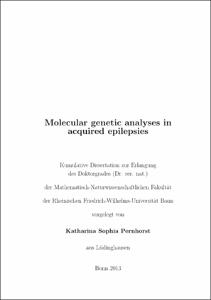Pernhorst, Katharina Sophia: Molecular genetic analyses in acquired epilepsies. - Bonn, 2014. - Dissertation, Rheinische Friedrich-Wilhelms-Universität Bonn.
Online-Ausgabe in bonndoc: https://nbn-resolving.org/urn:nbn:de:hbz:5n-34795
Online-Ausgabe in bonndoc: https://nbn-resolving.org/urn:nbn:de:hbz:5n-34795
@phdthesis{handle:20.500.11811/6014,
urn: https://nbn-resolving.org/urn:nbn:de:hbz:5n-34795,
author = {{Katharina Sophia Pernhorst}},
title = {Molecular genetic analyses in acquired epilepsies},
school = {Rheinische Friedrich-Wilhelms-Universität Bonn},
year = 2014,
month = feb,
note = {Focal epilepsies represent multifactorial disorders. Hence, pathogenetic factors, episodically shifting the brain over a virtual threshold to the emergence of seizures, are individually neither necessary nor sufficient. In recent years, several SNPs located in potential promoter regions of related genes have been detected in patients suffering from episodic CNS disorders. Transiently altered expression of corresponding genes therefore constitutes a potential pathogenetic aspect for the manifestation of episodic symptoms. The availability of biopsy tissue from epilepsy surgery of pharmacoresistant TLE patients provides a unique prerequisite in order to study the potential impact of gene promoter variants on transcription as well as the correlation of gene expression involved in neurotransmission and immune responses corresponding to stratification of patients according to clinical parameters.
The focus of this study was to gain further insights on the potential impact of SNPs located in transcriptional regulatory regions to modulate the expression of respective genes coding for neurotransmitter receptors including serotonin receptors and genes related to inhibition and neurotransmission, i.e. genes involved in γ-aminobutyric acid (GABA)-ergic homeostasis, on the basis of human surgical hippocampal brain tissue. By using real-time RT-PCR we found differential mRNA expression levels of relevant genes corresponding to the presence of respective SNP genotypes. To unravel the mechanisms of altered promoter control via regulatory SNP influence or aberrant transcription factor effects, we performed comprehensive bioinformatic analysis in order to identify binding sites for transcription factors and their potential modification by promoter SNPs. We observed that respective promoter SNPs affect transcription factor binding. Additionally, we showed an allele-dependent regulation of gene expression after exposure to relevant transcription factors using luciferase reporter asays.
Furthermore, given the potential impact of seizure frequency on gene expression, we analyzed the correlation of gene expression levels in surgical hippocampi from TLE patients with clinical or functional parameters. We found a significant correlation of expression of distinct mediator genes of inflammation to seizure frequency in human surgical brain tissue of pharmacoresistant TLE patients.
Our data indicate novel insights in the relevance of dynamic expression of genes related to neurotransmission and inflammation based on human brain tissue of TLE patients not responding to antiepileptic drugs.},
url = {https://hdl.handle.net/20.500.11811/6014}
}
urn: https://nbn-resolving.org/urn:nbn:de:hbz:5n-34795,
author = {{Katharina Sophia Pernhorst}},
title = {Molecular genetic analyses in acquired epilepsies},
school = {Rheinische Friedrich-Wilhelms-Universität Bonn},
year = 2014,
month = feb,
note = {Focal epilepsies represent multifactorial disorders. Hence, pathogenetic factors, episodically shifting the brain over a virtual threshold to the emergence of seizures, are individually neither necessary nor sufficient. In recent years, several SNPs located in potential promoter regions of related genes have been detected in patients suffering from episodic CNS disorders. Transiently altered expression of corresponding genes therefore constitutes a potential pathogenetic aspect for the manifestation of episodic symptoms. The availability of biopsy tissue from epilepsy surgery of pharmacoresistant TLE patients provides a unique prerequisite in order to study the potential impact of gene promoter variants on transcription as well as the correlation of gene expression involved in neurotransmission and immune responses corresponding to stratification of patients according to clinical parameters.
The focus of this study was to gain further insights on the potential impact of SNPs located in transcriptional regulatory regions to modulate the expression of respective genes coding for neurotransmitter receptors including serotonin receptors and genes related to inhibition and neurotransmission, i.e. genes involved in γ-aminobutyric acid (GABA)-ergic homeostasis, on the basis of human surgical hippocampal brain tissue. By using real-time RT-PCR we found differential mRNA expression levels of relevant genes corresponding to the presence of respective SNP genotypes. To unravel the mechanisms of altered promoter control via regulatory SNP influence or aberrant transcription factor effects, we performed comprehensive bioinformatic analysis in order to identify binding sites for transcription factors and their potential modification by promoter SNPs. We observed that respective promoter SNPs affect transcription factor binding. Additionally, we showed an allele-dependent regulation of gene expression after exposure to relevant transcription factors using luciferase reporter asays.
Furthermore, given the potential impact of seizure frequency on gene expression, we analyzed the correlation of gene expression levels in surgical hippocampi from TLE patients with clinical or functional parameters. We found a significant correlation of expression of distinct mediator genes of inflammation to seizure frequency in human surgical brain tissue of pharmacoresistant TLE patients.
Our data indicate novel insights in the relevance of dynamic expression of genes related to neurotransmission and inflammation based on human brain tissue of TLE patients not responding to antiepileptic drugs.},
url = {https://hdl.handle.net/20.500.11811/6014}
}






